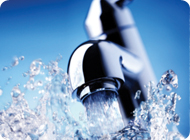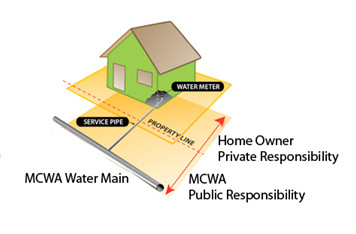
You Can Help!
You can help reduce exposure to lead in drinking water by identifying the material of your water service line and reporting the results.
Reducing Exposure to Lead in Drinking Water
Monroe County Water Authority is committed to providing a high quality, reliable water supply that meets or exceeds all state and federal water quality regulations. Water provided by MCWA is lead-free when it leaves our treatment plants; however, it can come into contact with lead as it flows through lead-containing household fixtures, household plumbing, and the service line that connects the public system to your home. In December 2021, the United States Environmental Protection Agency’s (USEPA’s) Lead and Copper Rule Revisions (LCRR) went into effect with the purpose of further reducing exposure to lead and copper in drinking water.
The Monroe County Water Authority takes the issue of lead in water very seriously. Exposure to lead can be harmful to people of all ages, particularly for infants and children. That is why MCWA is committed to working towards a lead-free future. To make this possible, we need your help to identify any remaining lead or galvanized service lines in our area.
Quick Links
Service Line Material Inventory
As part of our continued efforts to work towards a lead-free future, we have been working diligently to identify any remaining lead or galvanized lines in our distribution system. We are continually performing field work and reviewing records to update our inventory as additional materials are identified. These results are now publicly available in our Service Line Material Inventory, a regulatory requirement. Click the map below to search our inventory by address. If your service material line is unknown, please follow the directions here to identify and submit your results so we can update our database.

Help Us Get the Lead Out
What is a Water Service Line?
A water service line is the small diameter pipe that connects your home to the larger diameter distribution system water main typically located in or adjacent to the street.
Water service lines are owned in part by the MCWA and in part by you, the customer. The diagram to the right shows the delineation of the MCWA and homeowner’s responsibility for the service line. The MCWA is responsible for repair or replacement of the section of water service line located between the distribution system water main and the curb stop or shut-off valve typically located at the property or right-of-way line. The customer is responsible for the remaining section of water service line from the curb stop to the water meter.

Typically, water service lines are composed of either copper and/or plastic pipe materials. In the past, however, lead and/or galvanized steel were also used for service lines. Service lines composed of lead pipe can be a source of lead in the water. Service lines composed of galvanized steel can also be a source of lead in water since lead particles can attach to the inside of the galvanized steel pipe. Lead pipes were banned in the United States in 1986, and plumbing materials were required to meet federal “lead-free” specifications after this date.
What is MCWA Doing?
The MCWA has been testing the public water supply for lead since 1992 as required by the USEPA’s original Lead and Copper Rule (LCR) regulations. We can say with certainty that the water that leaves our treatment plants does not contain harmful levels of lead. Since testing was initiated in 1992, we have consistently been substantially below the regulatory lead concentration action level of 15 parts per billion. MCWA has also been replacing any MCWA owned lead service lines found in the public water system since the original LCR regulations were issued by the USEPA in 1991, even though it was not required.
Recently, MCWA expanded its Service Line Inventory efforts to enhance the inventory of water service material and identify any remaining lead or galvanized service lines throughout our service area. This includes service line inspections in the field, as well as enlisting the assistance of property owners to identify their internal service lines (see “What Can You Do” section below). Customers may see the MCWA and its contractors identifying water service line materials by conducting small excavations in the vicinity of curb boxes, which are typically located near the property or right-of-way line in the front yard. Customers will be notified prior to and following the investigation if any action is required on their part.
What Can You Do?
Because water service line ownership is shared between MCWA and the property owner, customer participation is vital to our efforts to minimize lead exposure.
We need your help to identify the material of your portion of the water service as it enters your home. Grab a magnet, a coin, and a flashlight and follow the video instructions below to determine the material of your service line. A PDF with instructions is available here.
Once you have identified the type of material, click here to submit your information to MCWA.
Reduce Exposure to Lead in Your Home
- Daily Flush – Any time water is not used for several hours (6 or more), flush your cold water pipes by running the water until it becomes as cold as it will get; this typically takes between 30 seconds and two minutes. This will bring in fresh water from the water main in the street to your tap, minimizing the amount of time any lead containing plumbing or fixtures are in contact with the water being used. After flushing, use the water for cooking or drinking, or save it for later use by filling pitchers. To conserve water, save the water from flushing the tap for watering plants or doing dishes.
- Use Cold Water – When using water for drinking or cooking purposes, use only cold water, especially when preparing baby formula.
- Pitcher Filter – There are filters available that can be installed to remove particulate lead. If you purchase one, we recommend you obtain one that has the National Sanitation Foundation’s “NSF 53” certification and follow the manufacturer’s recommendations for its maintenance. Learn more about filters here: https://info.nsf.org/Certified/dwtu/listings_leadreduction.asp.
- Remove lead containing fixtures/plumbing – The surest way to reduce exposure to lead in water is to remove and replace any fixtures or plumbing containing lead. Qualified plumbers can tell you for sure if you have any lead plumbing, check for lead solder in your internal pipes, look for fixtures containing lead and provide you the best information about replacement options and costs.
Can the water from my home’s plumbing be tested for lead?
ALS Environmental is a state-certified laboratory that offers lead testing. Their contact information is as follows:
ALS Environmental – Rochester
Phone: (585) 288-5380
Website: click here
Address: 1565 Jefferson Rd., Bldg 300, Suite 360, Rochester, NY 14623
Questions?
Please check out our list of Frequently Asked Questions here.
If you still have questions, please contact Customer Service at 442-7200, Monday to Friday, from 8:30 a.m. to 4:30 pm.
Additional Resources
- New York State Department of Health – Lead in Drinking Water
- EPA – Lead in Drinking Water
- EPA Safe Drinking Hotline: 1-800-426-4791
- CDC – Childhood Lead Poisoning Prevention
